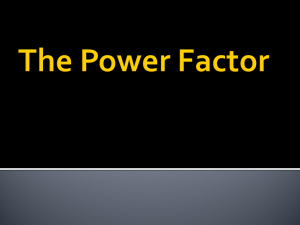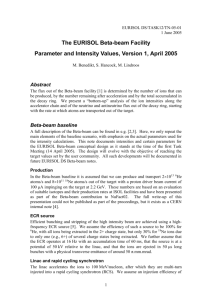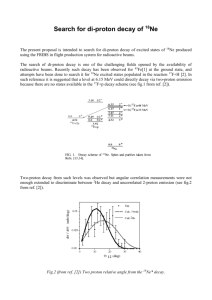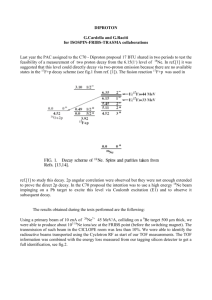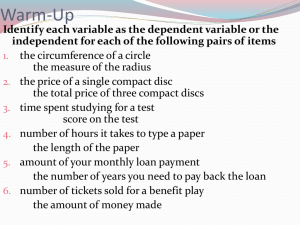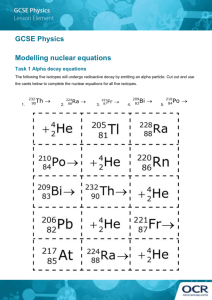(anti-) neutrinos from the EURISOL beta-beam facility
advertisement
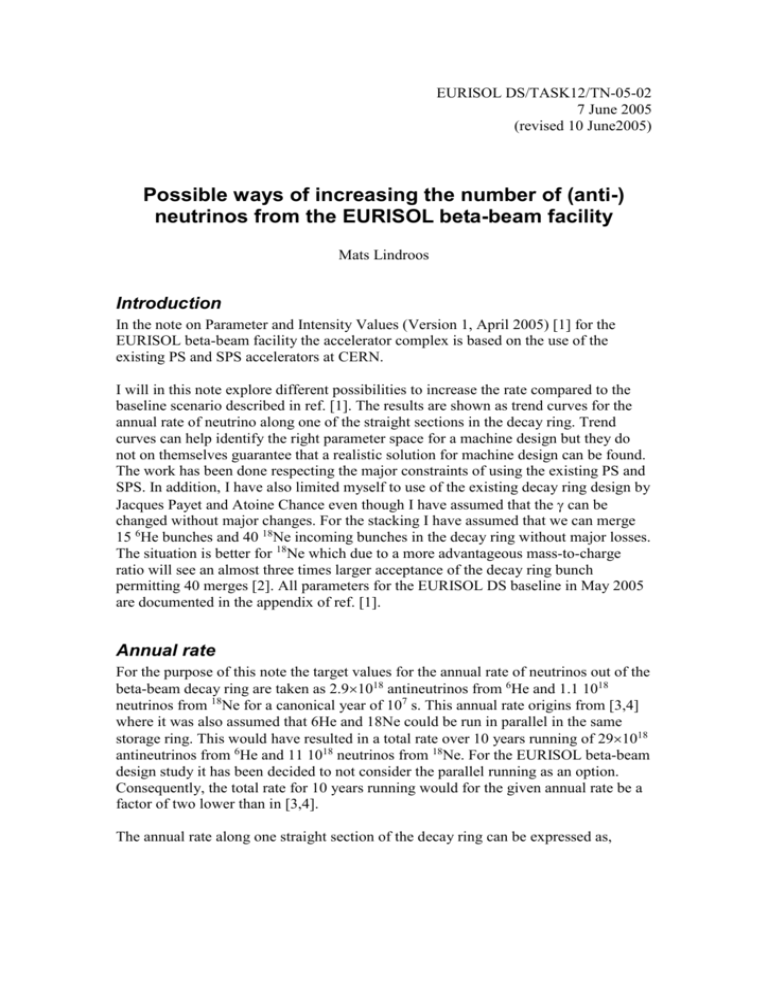
EURISOL DS/TASK12/TN-05-02 7 June 2005 (revised 10 June2005) Possible ways of increasing the number of (anti-) neutrinos from the EURISOL beta-beam facility Mats Lindroos Introduction In the note on Parameter and Intensity Values (Version 1, April 2005) [1] for the EURISOL beta-beam facility the accelerator complex is based on the use of the existing PS and SPS accelerators at CERN. I will in this note explore different possibilities to increase the rate compared to the baseline scenario described in ref. [1]. The results are shown as trend curves for the annual rate of neutrino along one of the straight sections in the decay ring. Trend curves can help identify the right parameter space for a machine design but they do not on themselves guarantee that a realistic solution for machine design can be found. The work has been done respecting the major constraints of using the existing PS and SPS. In addition, I have also limited myself to use of the existing decay ring design by Jacques Payet and Atoine Chance even though I have assumed that the can be changed without major changes. For the stacking I have assumed that we can merge 15 6He bunches and 40 18Ne incoming bunches in the decay ring without major losses. The situation is better for 18Ne which due to a more advantageous mass-to-charge ratio will see an almost three times larger acceptance of the decay ring bunch permitting 40 merges [2]. All parameters for the EURISOL DS baseline in May 2005 are documented in the appendix of ref. [1]. Annual rate For the purpose of this note the target values for the annual rate of neutrinos out of the beta-beam decay ring are taken as 2.91018 antineutrinos from 6He and 1.1 1018 neutrinos from 18Ne for a canonical year of 107 s. This annual rate origins from [3,4] where it was also assumed that 6He and 18Ne could be run in parallel in the same storage ring. This would have resulted in a total rate over 10 years running of 291018 antineutrinos from 6He and 11 1018 neutrinos from 18Ne. For the EURISOL beta-beam design study it has been decided to not consider the parallel running as an option. Consequently, the total rate for 10 years running would for the given annual rate be a factor of two lower than in [3,4]. The annual rate along one straight section of the decay ring can be expressed as, mergesratio spsrepetitiontime spsout straightfrac topt half 7 Annual _ rate 1 2 spsrepetio ntime 10 where the mergesratio is the number of merges that can be done in the decay ring without major losses from the process itself, spsrepetitiontime is the period for the fills in the decay ring, top the factor of the decay ring, thalf the half life at rest for the ions, spsout the total number of ions injected into the decay ring for each fill and straightfraction the fraction of the decay ring length for the straight section generating the neutrino beam. Ion production The production of 6He and 18Ne was investigated in ref. [5] in 2001. To reach the nominal annual rate without any changes to the baseline scenario described in note [1] the production would have to be increased. In table 1 the assumed possible production is compared to a theoretical required production. 6He 18Ne Nominal production rate from ref. [5] 2 10^13 8 10^11 Required production rate Missing factor 3.3 10^13 1.64 2.1 10^13 26.25 Table 1 The assumed possible production is compared to a theoretical required production. For the theoretically required production rate the number of 6He and 18Ne ions in each stage of the beta-beam base-line design can be calculated using the intensities.nb notebook from ref [1] and 40 merges in the decay ring for 18Ne [2]. 6He Source rate 3.28 1013 ECR 1.92 1012 RCS inj 9.55 1011 RCS 9.36 1011 PS inj 1.12 1013 PS 9.45 1012 SPS 8.92 1012 Decay Ring 9.53 1013 18Ne Source rate 2.1 1013 ECR 3.73 1011 RCS inj 1.86 1011 RCS 1.85 1011 PS inj 2.65 1012 PS 2.51 1012 SPS 2.48 1012 Decay Ring 7.28 1013 Gamma dependence The annual rate will depend on the of the decay ring due to the required acceleration time in the SPS and the increased life time of the decay ring. For given rf voltage, the longitudinal acceptance scales as the square root of (neglecting minor and relativistic dependences). This has in Mathematica notation been included as: Clear[mergesratio]; (* 18Ne: merges=40 and 6He: merges=15 *) mergesratio := merges Sqrt[topgamma/100] The acceleration time in the SPS has a minimum length depending on hardware limitations and is also increasing in steps of 1.2 seconds due to the basic timing period of the CERN accelerator complex. In figure 1 and figure 2 the dependence of 18Ne and 6He is shown respectively. The maximum that can be reached for 6He is 150 and for 18Ne 250. Annualrate 4 10 18 3.5 10 18 3 10 2.5 10 6He 18 18 80 1.5 10 100 120 140 18 Figure1: The annual rate of anti-neutrinos from 6He as a function of . The red dashed line shows the annual rate with the given source rate respecting a basic period of 1.2 seconds of the CERN accelerator complex. The solid line shows the same dependence but with a “smooth” choice of acceleration time for PS and SPS. The top blue dotted curve shows the dependence for 6He with the annual rate at =100 taken as the target value of 2.9 1018 anti-neutrinos per year. Annualrate 5 10 16 4.5 10 16 4 10 16 3.5 10 16 2.5 10 16 18 Ne 100 150 200 250 Figure2: The annual rate of neutrinos from 18Ne as a function of . The red dashed line shows the annual rate with the given source rate respecting a basic period of 1.2 seconds of the CERN accelerator complex. The solid line shows the same dependence but with a “smooth” choice of acceleration time for PS and SPS. Duty cycle dependence At least in theory, the available longitudinal acceptance for stacking in the decay ring can be increased by increasing the number of bunches in the decay ring. This will increase the duty cycle as the duty cycle is set by the total length in time of all bunches in the decay ring divided by the revolution time. The present limits of 15 merges for 6He and 40 merges for 18Ne is set by the available longitudinal emittance in the baseline design of ref. [1,2]. For both 6He and 18Ne this will truncate the stacking well before decay rate equals the stacking rate. In the formula for the annual rate the first factor is the result of this truncation. The nominal duty cycle in the beta-beam baseline is 2.2 10-3 for 8 bunches (50 ns total length) of either 6He or 18Ne at a Lorenz factor of 100. Figure 3 and 4 shows the annual rate as a function of number of bunches in the decay ring. All other parameters have been taken from the baseline design [1,2]. The duty cycle can be estimated for the given range of gammas in this note as N Dutyfactor bunches 0.0022 8 Annualrate 6He 3.2 10 18 3 10 18 2.8 10 18 2.6 10 18 2.4 10 18 2.2 10 18 1.8 10 20 18 40 60 80 Bunches Figure 3: The annual rate of anti-neutrinos from the decay of 6He as a function of number of bunches. The curve starts to the left with 8 bunches at the nominal duty cycle of 2.2 10-3 and saturates when the decay rate equals the stacking rate. Annualrate 9.5 10 16 9 10 16 8.5 10 16 8 10 16 7.5 10 16 6.5 10 16 18 Ne 20 40 60 80 100 120 Bunches Figure 4: The annual rate of anti-neutrinos from the decay of 18Ne as a function of number of bunches. The curve starts to the left with 8 bunches at the nominal duty cycle of 2.2 10-3 and saturates when the decay rate equals the stacking rate. Accumulation time In the beta-beam base-line [1] the ions are produced for one second and thereafter accelerate during several seconds to a of 100. During the acceleration no ions are produced. In theory, ions could be produced continuously as long as they can be stored while waiting for acceleration. There is optimum set by the life-time of the ion and the required acceleration time as can be seen in the trend curves in figure 5 and 6. The accumulation is in these calculations done at PS injection energy in a new radiation hard and separate storage ring. The storage ring will require a cooling system to reduce the longitudinal emittance of the stored ions. At PS injection the total longitudinal emittance of the ions must not exceed the emittance of the baseline beam to avoid setting new constraints on the following stages. In particular, it is very important for the stacking process. It would be more efficient to store the ions at a higher energy (life-time) but with the present limit on the PS acceleration time this can not be efficiently explored. Annualrate 18 3.5 10 18 3.25 10 18 3 10 18 2.75 10 18 2.5 10 18 2.25 10 1.75 10 18 6He 2 4 6 8 Accumulation s 10 time Figure 5: The annual rate of anti-neutrinos from 6He as a function of the accumulation time at PS injection energy. The red dashed line shows the annual rate respecting a basic period of 1.2 seconds of the CERN accelerator complex. The solid line shows the same dependence but with a “smooth” choice of acceleration time for PS and SPS. All other parameters have been taken from the baseline design [1,2] Annualrate 1.1 1 9 8 7 6 18 Ne 17 10 17 10 16 10 16 10 16 10 16 10 2 4 6 8 Accumulation s 10 time Figure 6: The annual rate of neutrinos from 18Ne as a function of the accumulation time at PS injection energy. The red dashed line shows the annual rate respecting a basic period of 1.2 seconds of the CERN accelerator complex. The solid line shows the same dependence but with a “smooth” choice of acceleration time for PS and SPS. All other parameters have been taken from the baseline design [1,2] Combining a higher gamma with a higher duty cycle The duty cycle of the beta-beam facility has to be low to suppress the background in the detector. At a higher this constraint is less severe. The trend curves in figure 7 and 8 show the annual rate as a function of for three different duty-cycles, 2.2 10-3, 4.4 10-3 and 6.6 10-3. The blue horizontal line shows the annual rate of the baseline [1] facility at a of 100. Annualrate 6 10 18 5 10 18 4 10 18 3 10 18 6He 80 100 120 140 Figure 7: The annual rate of anti-neutrinos from 6He as a function of for three different duty cycles. The lower red dashed line is for the nominal duty cycle [1] of 2.2 10-3, the solid middle line for a duty cycle of 4.4 10-3 and the green dotted line for a duty cycle of 6.5 10-3. The blue dashed horizontal line shows the annual rate of the baseline facility [1] at =100. Annualrate 1.2 10 1 10 18 Ne 17 17 8 10 16 6 10 16 4 10 16 2 10 16 100 150 200 250 Figure 8: The annual rate of neutrinos from 18Ne as a function of for three different duty cycles. The lower red dashed line is for the nominal duty cycle [1] of 2.2 10-3, the solid middle line for a duty cycle of 4.4 10-3 and the green dotted line for a duty cycle of 6.5 10-3. The blue dotted line shows the annual rate of the baseline facility [1] at =100. Charge state from ECR The biggest efficiency loss in the baseline design [1] for 18Ne is after the ECR source were only one charge state of 18Ne can be used for further acceleration. A brute force method to avoid this loss would be to build 3 linacs for parallel acceleration of ions up to 10 MeV/u, strip the ions and funnel them together for further acceleration. Any proposal for a more elegant and less costly solution would be most welcome. Conclusions The work demonstrates that the annual rate at a beta-beam facility can be increased compared to the baseline design and still make use of the existing accelerator infrastructure at CERN. The physics reach should now be studied for each of the options so that a common set of parameters for the beta-beam can be agreed upon. A “best case” scenario for a beta-beam facility at a of 100 optimizing on the annual rate would for 6He be and accumulation time in the PS of 4.3125 seconds and a SPS repetition time of 6 seconds at the baseline duty cycle and with the baseline ion production rate. The annual rate could in this case reach 3.45 1018 decays in the straight section with 1.13 1014 ions in the decay ring. The number of 6He ions in the different stages of the baseline would be Source rate ECR RCS inj RCS PS inj PS SPS Decay Ring 2. 1013 1.17 1012 5.82 1011 5.7 1011 1.33 1013 1.12 1013 1.06 1013 1.13 1014 A “best case” scenario for a beta-beam facility at a of 100 optimizing on the annual rate would for 18Ne be and accumulation time in the PS of 5.5625 seconds, a SPS repetition time of 7.2 seconds, three charge states accelerated from the ECR source at the baseline duty cycle and with the baseline ion production rate. The annual rate could in this case reach 3.43 1017 decays in the straight section with 2.23 1013 ions in the decay ring. The number of 18Ne ions in the different stages of the baseline would be Source rate ECR RCS inj RCS PS inj PS SPS Decay Ring 8. 1011 4.27 1010 2.13 1010 2.11 1010 1.05 1012 9.96 1011 9.83 1011 2.23 1013 Acknowledgements Many thanks to my colleagues Michael Benedikt and Adrian Fabich at CERN for helpful discussions. A special thanks to Steven Hancock at CERN for having created the Mathematica notebook intensities.nb [1] and taught me to use Mathematic more efficiently. Many thanks to Mauro Mezzetto for useful feedback on the first draft. References [1] [2] [3] [4] [5] M. Benedikt, S. Hancock and M. Lindroos, The EURISOL Beta-beam Facility Parameter and Intensity Values, Version 1, April 2005 S. Hancock, private communication, May, 2005 J. Bouchez, M. Lindroos and M. Mezzetto, Beta-beams: Present design and expected performance, In the proceedings of Nufact 03, New York, 2003 (IOP) J. Burguet-Castell, D. Casper, J.J. Gomez-Cadenas, P.Hernandez, F.Sanchez Neutrino oscillation physics with a higher gamma beta-beam, hep-ph/0312068 B. Autin, M. Benedikt, M. Grieser, S. Hancock, H. Haseroth, A. Jansson, U. Köster, M. Lindroos, S. Russenschuck and F. Wenander, "The acceleration and storage of radioactive ions for a neutrino factory", PS/OP/Note 2002-181.
